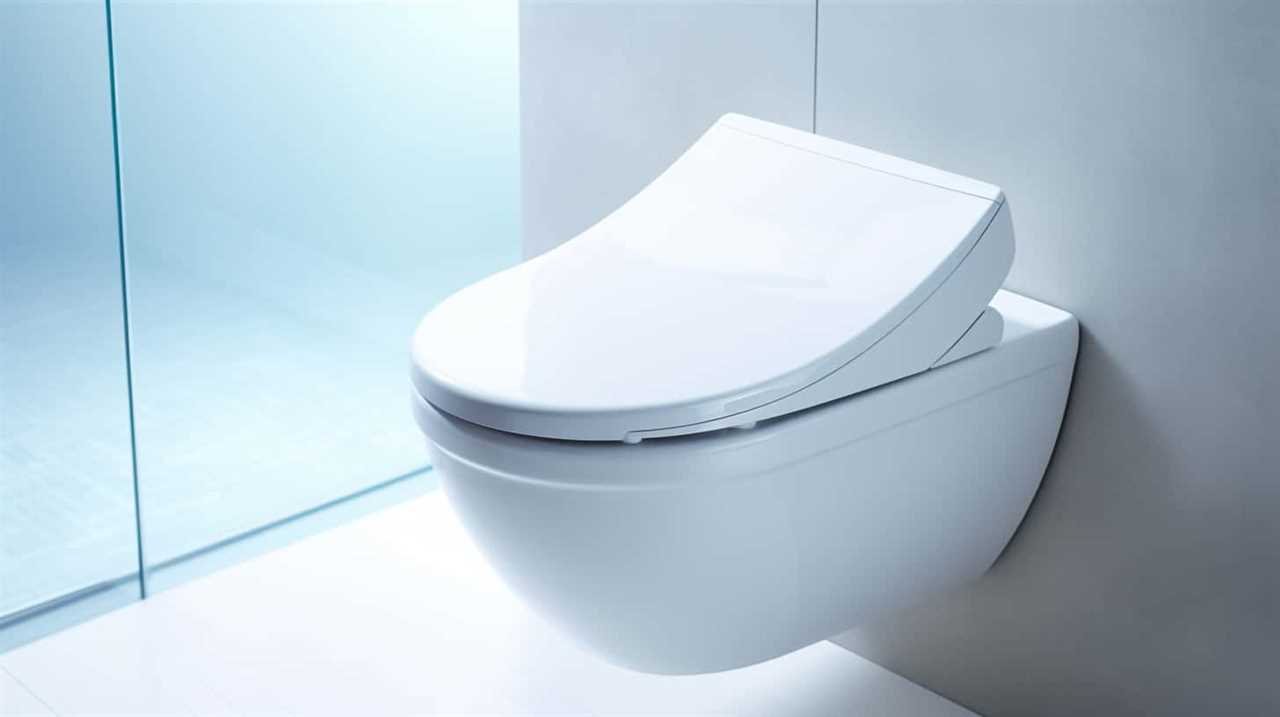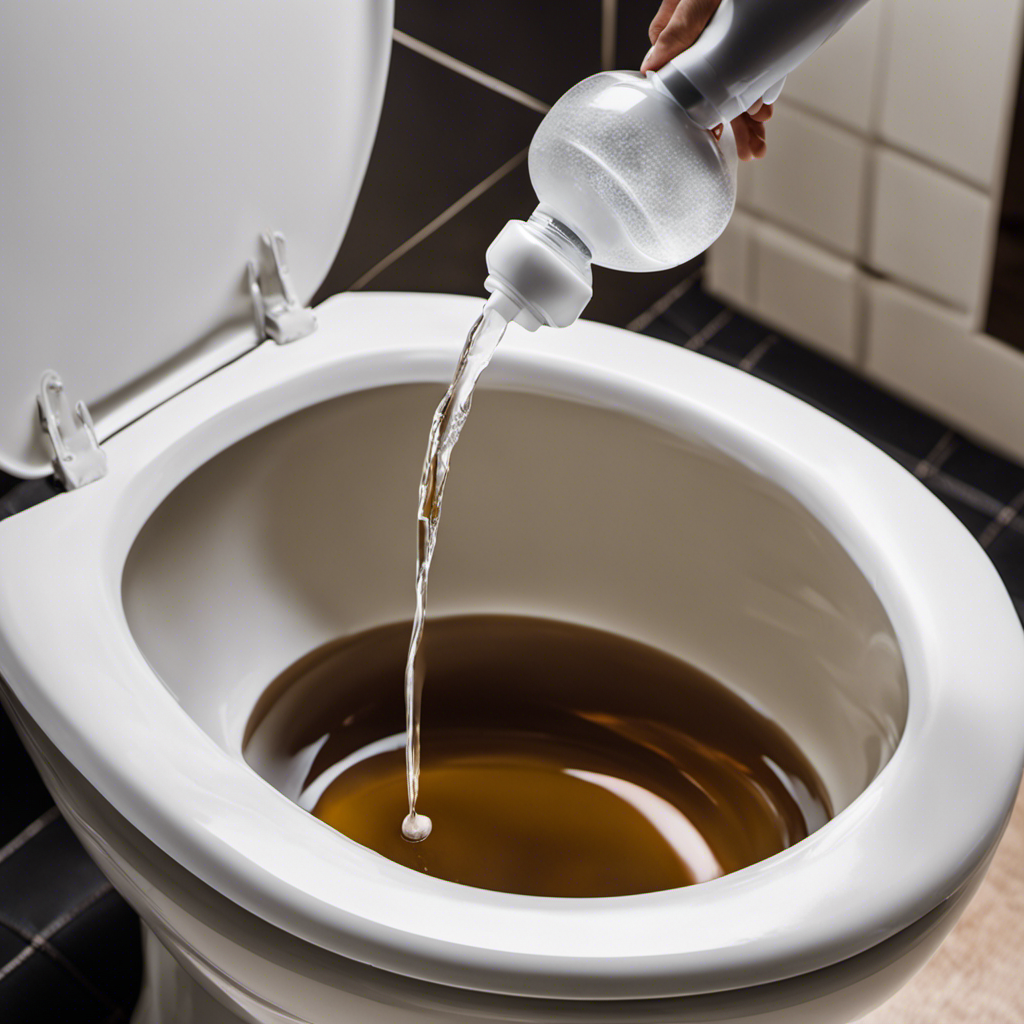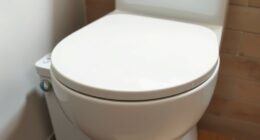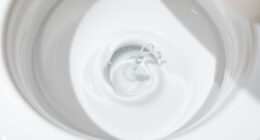I’ve tried countless products in my quest to find the ultimate solution for keeping my toilet seat sparkling clean. Let me tell you, it’s been quite the journey! But fear not, dear reader, for I have finally discovered the holy grail of toilet seat cleaning.
In this article, I will reveal the best natural cleaning agents, chemical-based cleaners, homemade solutions, and specialized toilet seat cleaners. Plus, I’ll even share some eco-friendly options for those who want to keep the planet happy while keeping their toilet seats pristine.
Get ready to bid farewell to those pesky germs and stains!
Key Takeaways
- Vinegar and water solution is a natural and effective cleaner for toilet seats, as it disinfects, removes stains, and eliminates odors.
- Baking soda is a useful ingredient for removing stubborn stains and deodorizing toilet seats when combined with vinegar or used alone.
- Chemical-based cleaners are convenient and time-saving options for quickly removing stains and killing bacteria on toilet seats, but they can contain harsh chemicals and emit strong fumes.
- Specialized toilet seat cleaners are designed to target grime and germs, providing an extra layer of protection and ease of use.
Natural Cleaning Agents for Toilet Seats
Using natural cleaning agents is a great way to effectively clean your toilet seat. Two popular options for naturally cleaning toilet seats are vinegar and baking soda.
Vinegar is a powerful disinfectant that can remove stains and eliminate odors. To use vinegar, simply mix it with water in a spray bottle and spray it onto the toilet seat. Let it sit for a few minutes before wiping it off with a cloth or sponge.
Baking soda is another excellent natural cleaner. It can help remove stubborn stains and deodorize the toilet seat. To use baking soda, sprinkle it onto the seat and scrub gently with a brush or sponge.
Additionally, essential oils like tea tree oil or lavender oil can be added to vinegar or baking soda solutions to provide a pleasant scent and enhance the cleaning power.
Chemical-Based Cleaners for Toilet Seats
When it comes to maintaining your toilet seat, you’ll find that chemical-based cleaners are effective options. They are designed to tackle tough stains, kill germs, and leave your toilet seat looking clean and fresh. However, it’s important to consider the pros and cons of using these cleaners.
Pros of chemical-based cleaners for toilet seats:
-
Effective cleaning: Chemical-based cleaners are specifically formulated to remove stains and kill bacteria, leaving your toilet seat hygienic.
-
Time-saving: These cleaners often work quickly, cutting down on cleaning time and effort.
-
Versatility: Many chemical-based cleaners can be used on various surfaces, making them a convenient choice for overall bathroom cleaning.
Cons of chemical-based cleaners for toilet seats:
-
Harsh chemicals: Some cleaners contain harsh chemicals that can be harmful to your health and the environment if not used properly.
-
Respiratory irritation: The strong fumes emitted by these cleaners can cause respiratory irritation, making it important to use them in a well-ventilated area.
-
Potential damage: Certain chemicals can deteriorate the finish of your toilet seat over time, so it’s important to follow the instructions and not leave the cleaner on for too long.
To properly use chemical-based cleaners for your toilet seat, follow these steps:
-
Read the instructions: Always read and follow the instructions provided by the manufacturer to ensure safe and effective use.
-
Apply the cleaner: Spray or apply the cleaner onto the toilet seat surface, making sure to cover all areas.
-
Scrub and rinse: Use a toilet brush or sponge to scrub the cleaner into the seat, paying extra attention to stained areas. Rinse thoroughly with water to remove any residue.
Remember to wear gloves and protective eyewear when handling chemical-based cleaners, and store them safely out of reach of children and pets.
Homemade Solutions for Toilet Seat Cleaning
One option for maintaining your toilet seat is to create homemade cleaning solutions. Vinegar and baking soda are effective ingredients for cleaning toilet seats. To make a simple solution, mix equal parts vinegar and water in a spray bottle. Spray the solution onto the toilet seat and let it sit for a few minutes. Then, sprinkle baking soda on a damp cloth and scrub the seat gently. Rinse with water and wipe dry.
Another option is to use lemon and salt. Cut a lemon in half and sprinkle salt on one half. Rub the lemon half with salt on the toilet seat, focusing on any stains or grime. Let it sit for a few minutes before rinsing with water and wiping dry.
Both of these homemade solutions are natural and safe for regular use.
Specialized Toilet Seat Cleaners
Specialized toilet seat cleaners can be more effective at removing tough stains and bacteria. They are specifically formulated to target the grime and germs that accumulate on toilet seats. Here are three reasons why specialized cleaners are a great option for keeping your toilet seats clean:
-
Targeted Cleaning: These cleaners are designed to tackle the specific challenges of toilet seat cleaning. They contain powerful ingredients that can break down stubborn stains and eliminate harmful bacteria.
-
Time-saving: Using specialized toilet seat cleaners can save you time and effort. They are often quick and easy to use, allowing you to efficiently sanitize your toilet seats without extensive scrubbing or rinsing.
-
Added Protection: Many specialized cleaners have disinfectant properties, providing an extra layer of protection against germs and bacteria. By using these cleaners regularly, you can help reduce the risk of cross-contamination and the spread of illnesses.
In addition to specialized cleaners, you can also use sanitizing wipes or disinfectant sprays for quick touch-ups and maintenance between deep cleanings. These products can help keep your toilet seats fresh and hygienic.
Eco-Friendly Options for Cleaning Toilet Seats
There are eco-friendly options available for maintaining the cleanliness of your toilet seats. When it comes to cleaning toilet seats, it’s important to consider sustainable and non-toxic options that can help reduce waste and protect the environment.
One of the zero waste alternatives for cleaning toilet seats is using vinegar and water solution. Vinegar is a natural disinfectant that can effectively remove germs and bacteria. Simply mix equal parts of vinegar and water, spray it onto the toilet seat, and wipe it clean with a cloth or sponge.
Another option is using eco-friendly toilet seat cleaners that are made from biodegradable ingredients. These cleaners are designed to be gentle on the environment while still effectively cleaning and sanitizing the toilet seat.
Frequently Asked Questions
What Are the Potential Risks of Using Chemical-Based Cleaners for Toilet Seats?
Using chemical-based cleaners for toilet seats can pose potential dangers and health risks. It’s important to be aware of the harmful effects they may have on our bodies and the environment.
Can I Use Natural Cleaning Agents for Toilet Seats if I Have Allergies or Sensitivities?
Yes, you can use natural cleaning agents for toilet seats if you have allergies or sensitivities. They are a great alternative to chemical-based cleaners and can effectively clean while minimizing potential irritants.
Are Homemade Solutions for Toilet Seat Cleaning as Effective as Commercial Cleaners?
Homemade solutions for cleaning toilet seats may not be as effective as commercial cleaners. While natural cleaning agents can be helpful for allergies or sensitivities, they may not provide the same level of cleanliness and disinfection.
How Often Should Specialized Toilet Seat Cleaners Be Used?
I clean my toilet seat regularly to ensure it’s free from germs. I rely on specialized toilet seat cleaners that effectively disinfect and sanitize. It’s important to follow proper toilet seat cleaning hacks to maintain a safe and hygienic bathroom environment.
Are Eco-Friendly Options for Cleaning Toilet Seats Safe for Septic Systems?
Eco-friendly alternatives for septic systems are safe for cleaning toilet seats. Common misconceptions about them often arise, but I assure you, they are effective and environmentally friendly.
Conclusion
After researching the best options for cleaning toilet seats, I have discovered a range of natural, chemical-based, homemade, and specialized cleaners. Each option has its own benefits and drawbacks, so it’s important to choose what works best for you.
However, I have found that there is a deeper meaning behind this quest for cleanliness. It is a reminder of our responsibility to maintain hygiene and cleanliness not just in our toilets, but in all aspects of our lives.
So, let’s clean our toilet seats and symbolically cleanse ourselves of any impurities, both physically and metaphorically.










